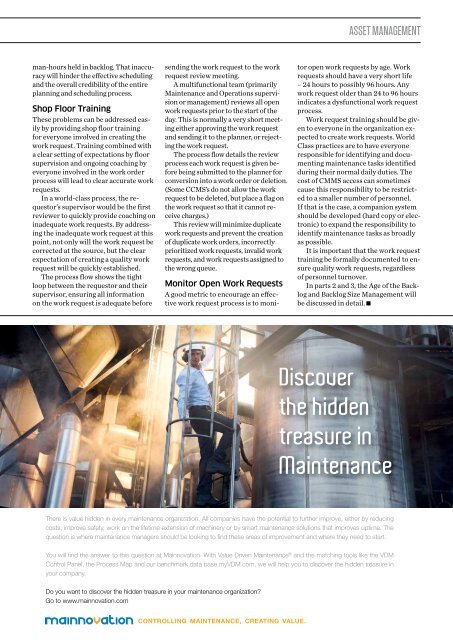Maintworld 3/2017
In this issue: Using Technology and Innovation to Manage Mega-Maintenance Challenges Identify the Root Cause of a Misalignment Condition Elements of a Good Preventive Maintenance Program
In this issue:
Using Technology and Innovation to Manage Mega-Maintenance Challenges
Identify the Root Cause of a Misalignment Condition
Elements of a Good Preventive Maintenance Program
Create successful ePaper yourself
Turn your PDF publications into a flip-book with our unique Google optimized e-Paper software.
ASSET MANAGEMENT<br />
man-hours held in backlog. That inaccuracy<br />
will hinder the effective scheduling<br />
and the overall credibility of the entire<br />
planning and scheduling process.<br />
Shop Floor Training<br />
These problems can be addressed easily<br />
by providing shop floor training<br />
for everyone involved in creating the<br />
work request. Training combined with<br />
a clear setting of expectations by floor<br />
supervision and ongoing coaching by<br />
everyone involved in the work order<br />
process will lead to clear accurate work<br />
requests.<br />
In a world-class process, the requestor’s<br />
supervisor would be the first<br />
reviewer to quickly provide coaching on<br />
inadequate work requests. By addressing<br />
the inadequate work request at this<br />
point, not only will the work request be<br />
corrected at the source, but the clear<br />
expectation of creating a quality work<br />
request will be quickly established.<br />
The process flow shows the tight<br />
loop between the requestor and their<br />
supervisor, ensuring all information<br />
on the work request is adequate before<br />
sending the work request to the work<br />
request review meeting.<br />
A multifunctional team (primarily<br />
Maintenance and Operations supervision<br />
or management) reviews all open<br />
work requests prior to the start of the<br />
day. This is normally a very short meeting<br />
either approving the work request<br />
and sending it to the planner, or rejecting<br />
the work request.<br />
The process flow details the review<br />
process each work request is given before<br />
being submitted to the planner for<br />
conversion into a work order or deletion.<br />
(Some CCMS’s do not allow the work<br />
request to be deleted, but place a flag on<br />
the work request so that it cannot receive<br />
charges.)<br />
This review will minimize duplicate<br />
work requests and prevent the creation<br />
of duplicate work orders, incorrectly<br />
prioritized work requests, invalid work<br />
requests, and work requests assigned to<br />
the wrong queue.<br />
Monitor Open Work Requests<br />
A good metric to encourage an effective<br />
work request process is to monitor<br />
open work requests by age. Work<br />
requests should have a very short life<br />
– 24 hours to possibly 96 hours. Any<br />
work request older than 24 to 96 hours<br />
indicates a dysfunctional work request<br />
process.<br />
Work request training should be given<br />
to everyone in the organization expected<br />
to create work requests. World<br />
Class practices are to have everyone<br />
responsible for identifying and documenting<br />
maintenance tasks identified<br />
during their normal daily duties. The<br />
cost of CMMS access can sometimes<br />
cause this responsibility to be restricted<br />
to a smaller number of personnel.<br />
If that is the case, a companion system<br />
should be developed (hard copy or electronic)<br />
to expand the responsibility to<br />
identify maintenance tasks as broadly<br />
as possible.<br />
It is important that the work request<br />
training be formally documented to ensure<br />
quality work requests, regardless<br />
of personnel turnover.<br />
In parts 2 and 3, the Age of the Backlog<br />
and Backlog Size Management will<br />
be discussed in detail.<br />
Discover<br />
the hidden<br />
treasure in<br />
Maintenance<br />
Discover<br />
the hidden<br />
treasure in<br />
Maintenance<br />
There is value hidden in every maintenance organization. All companies have the potential to further improve, either by reducing<br />
costs, improve safety, work on the lifetime extension of machinery or by smart maintenance solutions that improves uptime. The<br />
question is where maintenance managers should be looking to fi nd these areas of improvement and where they need to start.<br />
You will fi nd the answer to this question at Mainnovation. With Value Driven Maintenance ® and the matching tools like the VDM<br />
Control Panel, the Process Map and our benchmark data base myVDM.com, we will help you to discover the hidden treasure in<br />
your company.<br />
Do you want to discover the hidden treasure in your maintenance organization?<br />
Go to www.mainnovation.com<br />
CONTROLLING MAINTENANCE, CREATING VALUE.

















